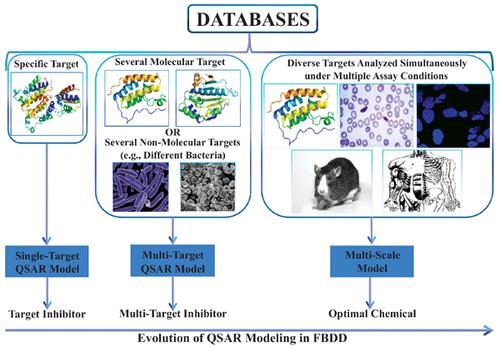Mini-Reviews in Medicinal Chemistry ( IF 3.3 ) Pub Date : 2020-07-31 , DOI: 10.2174/1389557520666200204123156 Valeria V Kleandrova 1 , Alejandro Speck-Planche 2

|
Fragment-Based Drug Design (FBDD) has established itself as a promising approach in modern drug discovery, accelerating and improving lead optimization, while playing a crucial role in diminishing the high attrition rates at all stages in the drug development process. On the other hand, FBDD has benefited from the application of computational methodologies, where the models derived from the Quantitative Structure-Activity Relationships (QSAR) have become consolidated tools. This mini-review focuses on the evolution and main applications of the QSAR paradigm in the context of FBDD in the last five years. This report places particular emphasis on the QSAR models derived from fragment-based topological approaches to extract physicochemical and/or structural information, allowing to design potentially novel mono- or multi-target inhibitors from relatively large and heterogeneous databases. Here, we also discuss the need to apply multi-scale modeling, to exemplify how different datasets based on target inhibition can be simultaneously integrated and predicted together with other relevant endpoints such as the biological activity against non-biomolecular targets, as well as in vitro and in vivo toxicity and pharmacokinetic properties. In this context, seminal papers are briefly analyzed. As huge amounts of data continue to accumulate in the domains of the chemical, biological and biomedical sciences, it has become clear that drug discovery must be viewed as a multi-scale optimization process. An ideal multi-scale approach should integrate diverse chemical and biological data and also serve as a knowledge generator, enabling the design of potentially optimal chemicals that may become therapeutic agents.
中文翻译:

基于片段的药物发现中的QSAR范例:从目标抑制剂的虚拟生成到多尺度建模。
基于片段的药物设计(FBDD)已成为现代药物发现中有希望的方法,它可以加速和改善先导物的优化,同时在降低药物开发过程中各个阶段的高损耗率中都起着至关重要的作用。另一方面,FBDD受益于计算方法的应用,其中从定量结构-活动关系(QSAR)派生的模型已成为合并工具。这份小型回顾着重于最近五年在FBDD中QSAR范式的演变和主要应用。本报告特别强调了从基于片段的拓扑方法中提取物理化学和/或结构信息的QSAR模型,可以从相对较大的异构数据库中设计潜在的新型单靶标或多靶标抑制剂。在这里,我们还讨论了应用多尺度建模的必要性,以举例说明如何基于靶标抑制作用将不同的数据集与其他相关终点(例如针对非生物分子靶标的生物活性)同时进行整合和预测以及体内毒性和药代动力学特性。在这种情况下,简要分析了开创性论文。随着化学,生物和生物医学领域内大量数据的不断积累,很明显,必须将药物发现视为多尺度的优化过程。理想的多尺度方法应整合各种化学和生物学数据,并可以作为知识的产生者,









































 京公网安备 11010802027423号
京公网安备 11010802027423号